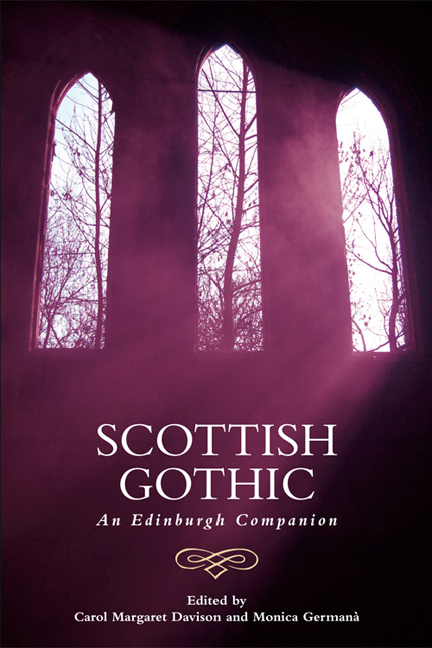Book contents
- Frontmatter
- Contents
- Acknowledgements
- 1 Borderlands of Identity and the Aesthetics of Disjuncture: An Introduction to Scottish Gothic
- 2 ‘The Celtic Century’ and the Genesis of Scottish Gothic
- 3 The Politics and Poetics of the ‘Scottish Gothic’ from Ossian to Otranto and Beyond
- 4 Robert Burns and the Scottish Bawdy Politic
- 5 Scottish Gothic Drama
- 6 Scottish Gothic Poetry
- 7 Calvinist and Covenanter Gothic
- 8 Gothic Scott
- 9 Gothic Hogg
- 10 ‘The Singular Wrought Out into the Strange and Mystical’: Blackwood's Edinburgh Magazine and the Transformation of Terror
- 11 Gothic Stevenson
- 12 J. M. Barrie's Gothic: Ghosts, Fairy Tales and Lost Children
- 13 The ‘nouveau frisson’: Muriel Spark's Gothic Fiction
- 14 Scottish Gothic and the Moving Image: A Tale of Two Traditions
- 15 New Frankensteins; or, the Body Politic
- 16 Queer Scottish Gothic
- 17 Authorship, ‘Ghost-filled’ Islands and the Haunting Feminine: Contemporary Scottish Female Gothic
- Notes on Contributors
- Index
16 - Queer Scottish Gothic
Published online by Cambridge University Press: 20 December 2017
- Frontmatter
- Contents
- Acknowledgements
- 1 Borderlands of Identity and the Aesthetics of Disjuncture: An Introduction to Scottish Gothic
- 2 ‘The Celtic Century’ and the Genesis of Scottish Gothic
- 3 The Politics and Poetics of the ‘Scottish Gothic’ from Ossian to Otranto and Beyond
- 4 Robert Burns and the Scottish Bawdy Politic
- 5 Scottish Gothic Drama
- 6 Scottish Gothic Poetry
- 7 Calvinist and Covenanter Gothic
- 8 Gothic Scott
- 9 Gothic Hogg
- 10 ‘The Singular Wrought Out into the Strange and Mystical’: Blackwood's Edinburgh Magazine and the Transformation of Terror
- 11 Gothic Stevenson
- 12 J. M. Barrie's Gothic: Ghosts, Fairy Tales and Lost Children
- 13 The ‘nouveau frisson’: Muriel Spark's Gothic Fiction
- 14 Scottish Gothic and the Moving Image: A Tale of Two Traditions
- 15 New Frankensteins; or, the Body Politic
- 16 Queer Scottish Gothic
- 17 Authorship, ‘Ghost-filled’ Islands and the Haunting Feminine: Contemporary Scottish Female Gothic
- Notes on Contributors
- Index
Summary
This chapter's analysis of queer Scottish Gothic originates from a simple observation: there is a large and coherent scholarship on queer Gothic and Scottish Gothic respectively; however, there is notably little analysis of the way Scottish and queer Gothic may interact. With the exception of one recent article by Fiona McCulloch, queer Scottish Gothic has not yet been given full critical attention. This chapter explores revisions in the treatment of Gothic monsters, traditionally viewed as ‘all that is dangerous and horrible in the human imagination’ (Gilmore 2003: 1), in Louise Welsh's The Cutting Room (2002), Luke Sutherland's Venus as a Boy (2004) and Zoë Strachan's Ever Fallen in Love (2011). More specifically, this analysis considers the dissociation of the monstrous figure from fear and terror in these texts, and suggests that they are repositioned as elusive figures through which the peripheral identities of Scottish and of queer may be simultaneously explored.
Torn between a dual British and Scottish identity, positioned as a marginal borderland to a civilised England, and haunted paradoxically by simultaneous ideas of its erased national identity and imperial sins, the Gothic resonates for Scotland in that it provides a site for the exploration of haunting and fracturing incoherencies inherent in the Scottish position as ‘other’ (Wright 2007: 73; Germanà 2011: 1–5; Morace 2011: 26). Meanwhile, critics of the queer Gothic draw attention to the genre's focus on transgression, perversion and the haunting disquiet of the conservative norm in their interlinked analyses of Gothic and queer (Haggerty 2004–5: 1; O'Rourke and Collings 2004–5: 15; Hughes and Smith 2009: 1). Clearly, then, Scottish and queer have both turned to the Gothic to explore that which is other, marginal and potentially disturbing to the (hetero)normative centre. Significantly, in exploring the origins of the word ‘uncanny’, Nicholas Royle deduces that ‘the “uncanny” comes from Scotland, from that “auld country” that has so often been represented as “beyond the borders”, liminal, an English foreign body’ (2003: 12). Elsewhere in The Uncanny, Royle writes that ‘the uncanny is queer.
- Type
- Chapter
- Information
- Scottish GothicAn Edinburgh Companion, pp. 208 - 221Publisher: Edinburgh University PressPrint publication year: 2017

